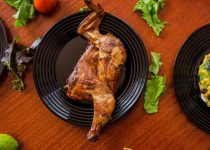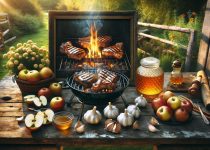How to Truss Turkey for Rotisserie
Ready to elevate your rotisserie game? Trussing your turkey is the key to achieving that perfect, juicy, and evenly cooked bird on the rotisserie. It's a skill that will take your culinary prowess to the next level.
The art of trussing not only ensures even cooking but also gives your turkey a beautiful, uniform shape as it spins and roasts to perfection. Let's dive into the mastery of trussing your turkey for the rotisserie, and soon you'll be impressing everyone with your perfectly cooked, succulent turkey.
Key Takeaways
- Select the right tools for trussing and preparing the turkey for rotisserie, including kitchen shears or a sharp knife, sturdy kitchen twine, a reliable rotisserie kit, a trussing needle, and heat-resistant gloves.
- Thoroughly clean and pat dry the turkey before trussing, removing giblets and neck from the cavity, and rinsing the turkey inside and out under cold water.
- Properly position and truss the turkey by placing it breast-side down, spreading out the wings, tucking the wings under the bird, and tying the legs together securely. Cross the legs tightly above the joint, loop twine around the crossed legs, make a firm knot, and cross the twine under the turkey's body near the tail. Bring the twine up and around the wings, crossing it over the top of the wings and tying it securely.
- Ensure safety when securing the trussed turkey on the spit and rotisserie by sliding the spit through the center of the turkey, balancing and securing the turkey on the spit, fastening the forks tightly, centering the turkey evenly, double-checking stability, using heat-resistant gloves, keeping a fire extinguisher nearby, avoiding overloading the rotisserie, and regularly checking the rotisserie's stability during cooking.
Select the Right Tools
What tools do you need to truss a turkey for rotisserie cooking?
First and foremost, you'll require a good set of kitchen shears or a sharp knife to cut the twine and trim any excess skin or fat from the turkey.
Additionally, you'll need some sturdy kitchen twine that can withstand the heat of the rotisserie.
When it comes to rotisserie equipment, a reliable rotisserie kit that fits your grill or oven is essential. Make sure it includes spit forks to secure the turkey in place and a motor to rotate it evenly.
As for trussing techniques, a solid trussing needle will be your best friend. It allows you to easily thread the twine through the turkey and secure the wings and legs, ensuring even cooking.
Lastly, having a pair of heat-resistant gloves will protect your hands when handling the hot rotisserie equipment.
With these tools in hand, you're well-equipped to master the art of trussing a turkey for rotisserie cooking.
Prepare the Turkey
To prepare the turkey for rotisserie cooking, after selecting the right tools, you'll need to thoroughly clean and pat dry the turkey to ensure it's ready for trussing. Start by removing the giblets and neck from the turkey's cavity, and then rinse the turkey inside and out under cold water. After cleaning, use paper towels to pat the turkey dry, ensuring there's no excess moisture on the skin. Once the turkey is clean and dry, it's time to season it. Apply your preferred turkey seasoning generously, both on the surface and inside the cavity, to infuse the meat with flavor as it cooks on the rotisserie.
Next, it's essential to truss the turkey properly to ensure even cooking on the rotisserie. Trussing involves tying the turkey securely with kitchen twine, ensuring the wings and legs are snugly tied to the body. This not only helps the turkey retain its shape but also promotes uniform cooking.
With the turkey cleaned, seasoned, and trussed, it's now ready to be placed on the rotisserie for a succulent and evenly cooked centerpiece to your meal.
Position the Turkey for Trussing
Now, you'll want to place the turkey breast-side down on a clean, flat surface to begin the trussing process. This positioning enables easy access to the cavity for stuffing and trussing. Ensure that the wings are spread out slightly to maintain balance and prevent them from flopping around during the trussing process.
Positioning the turkey breast-side down also allows for even cooking and ensures that the breast meat remains juicy and tender. When trussing, it's important to tuck the wings under the bird and tie the legs together securely to maintain a compact shape, promoting uniform cooking.
Additionally, positioning the turkey in this manner allows for the application of seasoning and marinade to penetrate the bird thoroughly, enhancing the flavor. As you prepare to truss the turkey, remember that proper positioning is crucial for a beautifully roasted, succulent bird.
Truss the Turkey's Legs
Now it's time to tackle trussing the turkey's legs. Cross the legs tightly and use kitchen twine to secure them in place.
Don't forget to secure the wings as well to ensure even cooking and a beautifully browned bird.
Cross Legs Tightly
Cross the turkey's legs tightly using kitchen twine, securing them together just above the joint. Start by crossing the legs, one over the other, and then loop the twine around them, pulling it taut to ensure a secure hold. After crossing and pulling the twine tight, make a knot to keep the legs in place.
Ensure that the knot is firm but not overly tight to avoid damaging the delicate turkey skin. The goal is to keep the legs close to the body, creating a compact shape for even cooking. This step is crucial for maintaining the turkey's form during the rotisserie process.
With the legs securely trussed, you're now ready to move on to the next stage of preparing your turkey for the rotisserie.
Use Kitchen Twine
Secure the turkey's legs tightly using kitchen twine, ensuring they're crossed and held close to the body for even cooking on the rotisserie. Start by cutting a piece of twine, placing it under the tail end of the turkey, then bringing it around the ankles, crossing them tightly.
Next, loop the twine around the ankles and tie it securely, ensuring the legs are held close to the body. This technique ensures that the turkey cooks evenly and retains its shape during the rotisserie process.
When trussing the turkey, it's important to use a figure-eight pattern around the legs to keep them firmly bound together.
These trussing tips will help you achieve a beautifully cooked rotisserie turkey with perfectly positioned legs.
Secure Wings as Well
To truss the turkey for rotisserie, start by ensuring the wings are tightly secured to the body using kitchen twine. Cross the kitchen twine under the turkey's body, near the tail. Then, bring the twine up and around the wings, pulling them close to the body. Cross the twine over the top of the wings and bring it back around to the starting point, tying it securely. This securing method ensures that the wings are held snugly against the turkey's body, preventing them from flapping and potentially burning during the rotisserie cooking process.
Proper wing placement is crucial for even cooking and a beautifully browned bird. By following these steps, you'll achieve a securely trussed turkey, ready for the rotisserie.
Truss the Turkey's Wings
Now, let's tackle the task of trussing the turkey's wings.
You want to make sure the wings are secured tightly to the body to prevent uneven cooking.
This step is crucial for achieving a perfectly rotisserie-cooked turkey.
Secure Wings Tightly
You'll tightly secure the turkey's wings with kitchen twine, wrapping them close to the body to prevent burning and ensure even cooking on the rotisserie. Proper trussing technique is essential to maintain the turkey's shape, allowing it to cook evenly and retain moisture.
When trussing, the wings should be tucked tightly against the body to prevent them from overcooking and becoming dry. This step is crucial in ensuring that the turkey cooks uniformly, as loose wings can lead to uneven cooking and potential burning on the rotisserie.
Prevent Uneven Cooking
Secure the turkey's wings tightly against the body with kitchen twine to prevent uneven cooking on the rotisserie. Trussing the wings close to the body ensures that the turkey cooks evenly, allowing the heat to penetrate all parts of the bird uniformly.
Uneven cooking can result in dry, overcooked areas and undercooked spots, affecting the overall flavor and texture of the turkey. To achieve even cooking, use trussing techniques that involve crossing the twine over the wings and pulling them in snugly. This method keeps the wings in place and close to the body, promoting consistent heat distribution during rotisserie cooking.
Secure the Trussed Turkey Onto the Rotisserie Spit
To secure the trussed turkey onto the rotisserie spit, carefully slide the spit through the center of the turkey, ensuring it is balanced and secure. Once the turkey is in place, fasten the forks tightly to hold it in position. Ensure that the turkey is evenly centered on the spit to prevent imbalance during the cooking process. Here's a table to highlight some essential rotisserie safety tips:
| Rotisserie Safety Tips |
|---|
| 1. Ensure the rotisserie is securely assembled and balanced. |
| 2. Use heat-resistant gloves when handling the spit and turkey. |
| 3. Keep a fire extinguisher nearby in case of any flare-ups. |
| 4. Avoid overloading the rotisserie with excessive weight. |
| 5. Regularly check the rotisserie's stability during the cooking process. |
Following these safety tips will help ensure that your rotisserie experience is not only delicious but also safe. When securing the trussed turkey onto the rotisserie spit, these precautions are vital for a successful and trouble-free cooking experience.
Frequently Asked Questions
Can I Truss a Turkey Without Using Kitchen Twine?
You can truss a turkey without using kitchen twine by using silicone bands or skewers as trussing alternatives. These options help secure the turkey for even cooking and can be easily removed after the turkey preparation.
How Do I Know if My Rotisserie Spit Is the Right Size for My Turkey?
To measure your rotisserie spit for the right turkey size, first check the maximum weight and length your rotisserie can handle. Then, measure your turkey to ensure it fits within those parameters. Consider trussing methods and rotisserie alternatives if needed.
Can I Use a Different Method to Secure the Trussed Turkey Onto the Rotisserie Spit if I Don't Have the Specific Equipment Mentioned?
If you don't have the specific equipment, there are alternative methods and DIY solutions to secure the trussed turkey onto the rotisserie spit. Look for sturdy kitchen twine or metal skewers for a secure hold.
Is It Necessary to Truss the Turkey if I'm Using a Rotisserie?
You don't have to truss the turkey for rotisserie cooking, but it can help with even cooking. Try trussing alternatives like using butcher's twine. Rotisserie benefits include juicy, evenly cooked meat and crispy skin.
What Should I Do if I Don't Have a Rotisserie but Still Want to Cook a Trussed Turkey?
If you don't have a rotisserie, you can still cook a trussed turkey using alternative cooking methods like roasting or grilling. These techniques ensure even cooking and a beautifully presented bird. Experiment with different trussing alternatives for best results.



